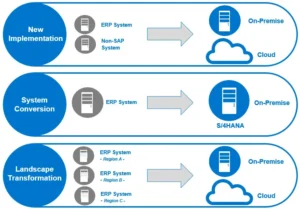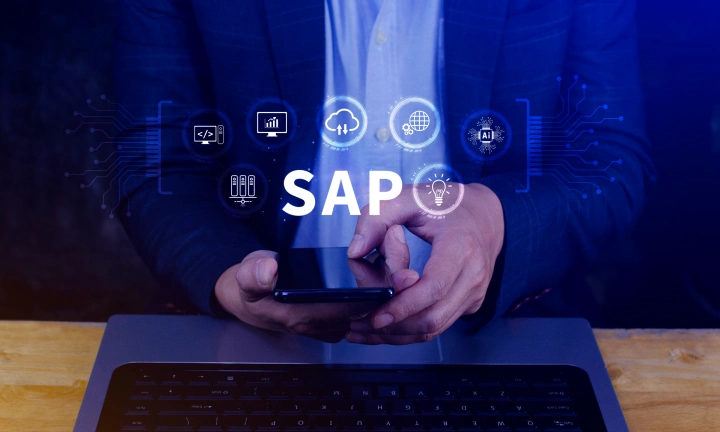SAP’s intelligent Enterprise Resource Planning and Advanced Business Suite S/4HANA need no introduction. With time, more and more companies are either planning to migrate to SAP S/4HANA or have already moved to the platform. According to Statista, about 10,900 companies have already purchased S/4HANA subscriptions or licenses in the first quarter of 2019.
Before we proceed further, let’s begin with an important announcement. SAP has announced that it will not support its HANA business suite from 2025. You may think that you have ample time for a transition, but it’s not very early to move to S/4HANA.
Moreover, owing to cutthroat competition, business enterprises need to focus on improved performance, real-time data access, agility, and bring innovation. Implementing SAP S/4HANA in your business process will help you reap all the above benefits in one go.
Three Important Transition Scenarios
Migrating to SAP S/4HANA is a complex undertaking. It is because the SAP systems use various applications. Also, you need to choose a deployment model such as Software-as-a-Service (SaaS), Infrastructure-as-a-Service (IaaS), or on-premise.
Image Source: SAP official blog
However, let’s not make it more complicated. I’ll discuss three transition scenarios that you can take to move to SAP S/4HANA.
Brownfield Approach or System Conversion
The System Conversion or Brownfield approach is a comprehensive transformation of an existing Business Suite to S/4HANA. This transition path is technically related to the Software Update Manager (SUM). But if the customer is not using the existing ERP Business Suite or HANA, then SAP experts have to use Database Migration Option (DMO) as an underlying database.
But to tell you the truth, the process isn’t that simple. This is because you have been using your current ERP module for many years and might have got it customized according to specific needs. Thus, migrating customized tools can be a difficult task.
You may have to face a setback when you are opting for this transition scenario. So, it is advisable to only go for a technical upgrade. The migration process will speed up and you will need to fix the issues once the procedure is complete.
New Implementation or Greenfield
As the name suggests, Greenfield or New Implementation suggests a new approach to S/4HANA migration. This transformation scenario is highly suitable for any organization that is moving on to SAP for the first time. Secondly, the Greenfield method will fit your needs if your enterprise does not have a complicated architecture with mutual dependencies between SAP systems.
The process implements SAP S/4HANA with master and transitional data moving from the legacy system. SAP professionals need to use standard data migration tools and content.
The New Implementation environment offers the benefit of bimodal IT supporting business processes for both the legacy system and rapid development. In short, it makes your business more agile.
Landscape Transformation or Consolidation
Consolidation or Landscape Transformation helps in transforming your existing regional ERP Business Suite into a global SAP S/4HANA landscape. It is also a split out of different parts of a system. The consolidation of regional HANA into a single S/4HANA global system helps in enhancing your business productivity and efficiency. Also, you can centralize a few of your financial tasks such as migrating the finance data to a more advanced ERP model.
Steps for a Seamless SAP S/4HANA Migration
It has become essential to get familiar with the steps that will allow us to smoothly implement the next-generation ERP Business Suite successfully.
Identifying and Accessing the Existing SAP Environment
First things first, it is important to identify and assess the existing state of the SAP Environment. You also need to analyze what your purpose is or aim behind migrating to S/4HANA, keeping in view the challenges faced by your business. It will help you identify the legacy system, which needs to be replaced or removed.
Next, is searching out for an experienced and reliable SAP Consultant Company that can guide you through the entire process. You need to be careful while choosing the existing environment that needs to be migrated. Discuss at length with your consultant about which transitional scenario will perfectly suit your business objectives and escalate its agility. You might be preferring some elements of the current ERP model, but when you travel to a new module, it will be more beneficial in the long run.
It is to be noted that SAP S/4HANA offers several applications with several handy features. Unfortunately, SAP HANA users are not able to take advantage of all features, with upgrades. That provides sufficient reason for moving to S/4HANA.
Defining the Plan of Action
In the second step, you have to focus on defining the roadmap or plan of action to implement SAP S/4HANA on a successful note. It will make your employees understand how S/4HANA is going to benefit the organization as a whole and help in achieving the set target. Before that, you need to consider the following important points such as-
- What specific S/4HANA functionalities will help to benefit the infrastructure and data management of the business organization.
- Which are the areas where your business is lacking behind that can be resolved by S/4HANA?
- Deciding when you want to migrate to an advanced ERP system
- You need to look at whether SAP S/4HANA is compatible with your existing ERP module. You also have to decide if you only need to update the current system or implement an entirely new environment.
- You need to see whether the migration to S/4HANA is going to influence any third-party applications or systems. Your consultant will let you know if any updates to third-party apps are needed.
- You also need to take a note on if SAP S/4HANA is missing out on functionality, which is available in SAP HANA. If yes, whether it is possible to integrate that function into S/4HANA.
Identifying the roadmap will support constructing a business case for SAP S/4HANA.
Migrating Data to SAP S/4HANA
Data Migration is a complicated and extensive task and so you have to follow the best practices while transferring it. It must be remembered that S/4HANA on-premise and S/4HANA Cloud are the two basic targets for which new implementation provides support. Data migration takes place through the SAP S/4HANA Migration Cockpit tool, an innovative tool that is only obtained for cloud release. However, with recent updates, this facility is offered for the on-premise version as well.
There is another tool known as the SAP S/4HANA Migration Object Modeler that is only available for on-premise. It is also seen as a design-time tool. It helps in displaying a summary of the target structures, editing, the source structure, and editing the field mapping.
The third tool in the process is Rapid data migration with Data Service. It improves the efficiency of data extraction, transformation, and load. Apart from that, it also provides competencies for data quality management and data text processing.
Building the Right Architecture
With time, SAP has become much more advanced, introducing various cutting-edge technologies that help the business to remain up-to-date and productive. There has also been a sea change in the needs and demands of tech-savvy customers, who have far wider options than ever before. The existing ERP Business Suite may not be able to deliver an optimum user experience due to the lack of some key features.
We mentioned that SAP offers a wide spectrum of products such as SAP Fiori, which is a new software that personalizes and simplifies the user experience of SAP applications. Imagine implementing Fiori and S/4HANA. It offers a unified experience across business lines, improving customer satisfaction. It also reduces costs as customers get real-time information on products and services.
With SAP S/4HANA, the employees can get remote or mobile access to back-end environments. Corporate travelers, for example, can view data from their data from devices with the need for any VPN service or Wi-Fi facility.
Adept Knowledge of SAP S/4HANA
So, we discussed designing the architecture for the implementation of SAP S/4HANA. But did you go through the profile of an SAP expert and check his experience in the field? A SAP professional will have adept knowledge of HANA and S/4HANA. He leverages new technologies, user interfaces, and processes into your system.
Conclusion
It is the right time to migrate to SAP’s advanced ERP Business Suite. However, before you plan to move to S/4HANA, it’s important to understand and access your current business landscape and customer demand to increase agility and productivity. If you are looking for an adept SAP Consultant Firm, which can help in migrating your existing ERP Business Suite to S/4HANA, get in touch with the experts today.






